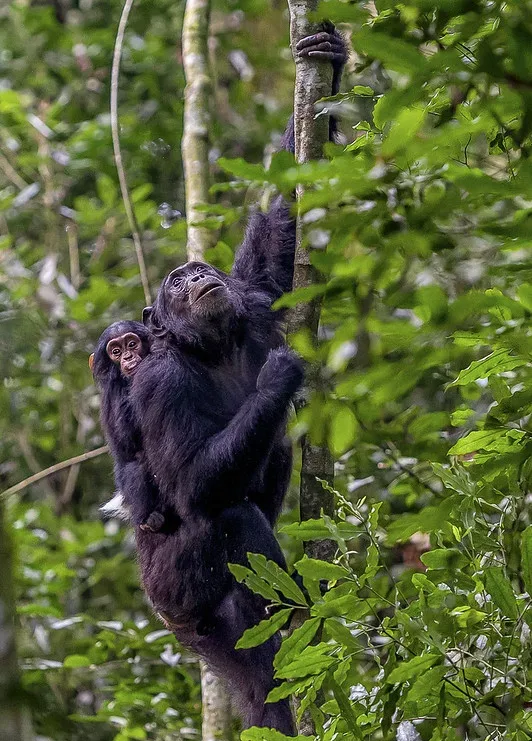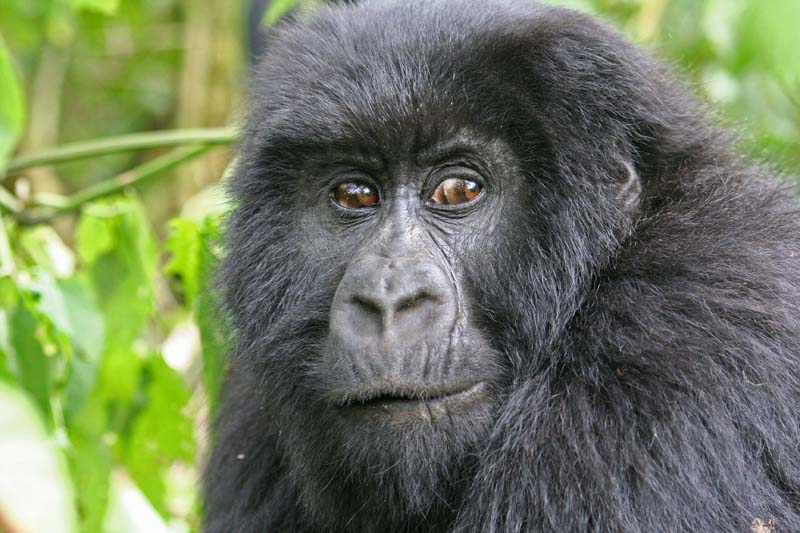Why are Bwindi chimpanzees not habituated.
Other than any other primates living in Bwindi Impenetrable National Park, the mountain gorillas are the most popular attractions there are. Though they reside among the accustomed mountain gorilla families, chimpanzees are more mobile and so habituating them may superseded the main goal of gorilla preservation—that of which this park serves.
Only in South Western Uganda, where mountain gorillas dwell alongside wild Chimpanzees, is Bwindi Impenetrable National Park located on Planet Earth. When you discuss Bwindi area as a National Park, people’s thoughts turn to gorilla tracking little knowledge of chimpanzees also being in the same area. For curious tourists, this little knowledge about chimpanzees in Bwindi renders them invisible.
Many activities in Bwindi Impenetrable National Park surrounds the mountain gorillas and other primates, often referred to as others. Among the other primates are chimpanzees, blue monkeys, grey cheeked mangabey, red tailed monkeys, black and white colobus, L’Hoest’s to name but a few.
Given that the forest has wild chimpanzee populations, why are they not habituated if such is actually true? Several factors might help to explain this. Here we have opportunities rather than real motivations.
Why are chimps in Bwindi Impenetrable National Park not habituated?
Research done by Stanford in 1997 in Nkuringo revealed that this area contains chimpanzees living in a community of roughly forty members. When combined with those in Buhoma, it was estimated that the total population of chimps in the entire village could be 350 to 400 individuals. Of fact, improved conservation policies in Bwindi Impenetrable National Park should have led to higher populations since 1997.
This study also showed that Bwindi Chimpanzees are more bipedal grazing on bushes and trees than mountain gorillas and more apparent overall. Unique behavior noted among chimps in Kayonza was constructing nests on ground, which might draw visitors if habituated. As noted by researchers, the chimpanzees thrive in Bwindi forest utilizing equipment to collect honey, therefore augmenting their diet.
Some of these factors are only hypotheses as the authorities of the Bwindi Impenetrable National park have not publicly stated why they have not been in position to habituate the chimpanzees. Several factors may be developed to help to explain why chimpanzees in Bwindi Impenetrable National park are not habituated.
Other Chimpanzee Trekking Destination Competitiveness in Uganda
There are better areas in Uganda with more chimpanzees than in Bwindi Impenetrable National Park. Kaniyo Pabidi inside Budongo Forest Murchison Falls National Park, Kibale National park, Kyambura Gorge in Queen Elizabeth National Park, Kalinzu Forest Reserve as well other forest in Uganda.
These have more chimpanzees than Bwindi impenetrable National Park. This implies that in such areas, researchers can afford to habituate some and leave others in their wild/natural state other than habituating the handful that are in Bwindi Impenetrable National park.
Features of Bwindi Impenetrable National Park Topography
Bwindi Impenetrable National Park has the most difficult terrain among other forest areas in Uganda containing chimpanzees. A low land forest is Kibale National Park; a highland tropical rainforest is Bwindi Impenetrable National Park. This so raises a question as chimpanzees may occasionally be mobile. Trekking them in Bwindi Impenetrable National Park might provide more difficulties than in lowland areas of Kibale National Park.
Government Policy Via Uganda Wildlife Authority
Another explanation for Bwindi Forest chimpanzees’ lack of habitation might be government policy of fair distribution of revenue producing resources. Uganda’s government wants every area to have many attractions so that visitors could profit from travel.
If for instance chimps in Bwindi Impenetrable National park are habituated, visitors may decide to exclude Kibale national park from the itinerary and favor gorillas and chimpanzees in Bwindi Impenetrable National park instead. Most visitors won’t have any justification for visiting another park for chimpanzee trekking. One stop shop for monkey safaris in the nation may be Bwindi Impenetrable National Park.
Preserve Bwindi Impenetrable National Park’s ecosystems
Since Bwindi Impenetrable National Park is an ecotourism destination, they may not habituate chimpanzees as more people visiting the jungle would result. This so strains the little natural resources found in the forest.
 The primarily vegetarian mountain gorillas rely on the forest’s vegetation for their survival. Should numerous people with various motives for visiting the forest be let into the forest, they might trample on the plants restricting the gorilla’s food supply.
The primarily vegetarian mountain gorillas rely on the forest’s vegetation for their survival. Should numerous people with various motives for visiting the forest be let into the forest, they might trample on the plants restricting the gorilla’s food supply.
To sustain their enormous size both during the day and at night, a grown gorilla must eat over 300 pounds of food in a day. This is among the factors influencing the one-hour restriction on the time spent with the mountain gorillas during gorilla trekking. This lets them eat enough vegetation free from intervention. The mountain gorillas eat bamboo, soft stems, leaves, fruits, and others.
Restricted Resources for Carrère for Gorilla Habituation and Chimpanzee Habituation
The little financial support for mountain gorilla research in Bwindi Impenetrable National Park will be weighed down by adding chimpanzee habituation.
Visiting Bwindi Impenetrable National park is mostly driven by mountain gorillas, so this has to be given top importance. By the 1980s, mountain gorillas were almost extinct due to questionable human actions such poaching, habitat encroachment, and one of the ways to stop this was to get people near to them. Should you overrule the forest with unbridled activity, the rationale for gorilla habituation is lost.
Perhaps difficult to restrict the habituated chimpanzees from not crossing the habitat of the mountain gorilla
Limiting a chimpanzee population from not crossing to where the gorilla families live would be difficult. Since people may freely see both gorilla trekking and chimpanzee trekking simultaneously, this serves no use to the visitors paying for either activity since it may restrict the revenue gathered to support the conservation goal of this forest, mountain gorillas.
Restricted Professional Service (rangers) In order to assist both activities
It takes time and personal effort to train the ranger guide; this is not an easy job. The rangers must have accurate knowledge at hand and physically learn about the residents of Bwindi Impenetrable national park. This is not a one-day success; so, a lot of time is required to produce such a person. Should chimpanzee trekking be included into Bwindi Impenetrable National Park’s activities, focus on knowledge is split. This results in a less knowledgeable personnel for Uganda Wildlife Authority.
The Nature of the Chimpanzees Unlike Mountain Gorillas
When both the chimpanzees and mountain gorillas are habituated in the same forest Bwindi Impenetrable National park, anarchy may arise in the forest since in nature the chimpanzees are faster in mobility than mountain gorillas. Those looking for the chimpanzees could stroll across a session of gorilla trekking to catch up with the chimps. This could set the forest in a disorganized state.
Paying a high price for a gorilla permit is meant to exhaust the whole hour of gorilla viewing free from interference. Frustrated, the gorillas might hide in case they are ambushed by more visitors including those engaged in chimpanzee trekking.
Mass tourism in Bwindi Impenetrable National Park
Being a biosphere reserve, Bwindi Impenetrable National Park may be overwhelmed by the simultaneous high volume of visitors depending on its resources. Considered locally as Impenetrable, Bwindi is an ancient forest thought to have endured the ice age. The type of this forest calls for this name. Currently rare worldwide, the forest has survived over 300000 years housing a great abundance of fauna and flora.
Its special character led the local and international conservation organizations to remove the Batwa Pygmies whose life depended on the forest supply since time memorial. They moved into nearby towns close by. Their many fascinating tales about surviving in the forest and their experiences there abound. Only songs, dances, and other cultural events allow one to show all this legacy lost. Even the visitor count has to be under control if we are to maintain the intention behind doing this eviction.
Whatever the reason, the fact remains that all chimpanzees in Bwindi Impenetrable National park are not habituated at the moment and we wait to see if the government/researchers will look at it in the near future.
When To Visit Bwindi Impenetrable National Park
For whatever reason you choose to visit Bwindi Impenetrable National park, its is open throughout the year. The most desired time however is the dry season that is June to September or December to January when less rains are received. The ground receives some sunray penetration to keep it drier and rivers do not overflow.
The nature of the soil in this park is volcanic which gets slippery when too much water flows over it. The severe wet seasons normally have soggy grounds, which makes the trek in the forest quite challenging in case you need to hike to get to the mountain gorillas during gorilla trekking. The wet season is normally March to May and November.
Even birding in Bwindi Forest is more interesting in the drier seasons when the birds come out freely from there nest to feed or construct nests.
What To Pack For A Tour To Bwindi Impenetrable National Park
Packing for a visit to Bwindi Impenetrable National park must be relevant to the activities you hope to do while on ground. Over packing may create discomfort for you while under packing may cause you not to have fun during your Africa Safari.
Safari tracking boot for you to wear and protect your feet from getting injured while in the wilderness especially when walking over soggy surfaces.
A camera, which is soundproof in case you have to do gorilla trekking in Bwindi impenetrable National Park. The Mountain gorillas are frightened by unfamiliar sounds in there vicinity.
Insect repellant to keep stinging insects away from hurting you.
Safari hat to protect your head from flying insects and water dripping off the tree leaves.
First Aid Kit to use for administering emergency treatment in case you get an accident while on safari
A pair of pajamas for nighttime dressing as you go to sleep
Safari attire in colors that are wilderness friendly that is to say Khaki and tan. They must be long trousers and shirt that can protect you from the harsh conditions in the forest that you may come across like stinging nettles.
A waterproof backpack to carry in your belongings when in the forest
A travel adapter and charger to use in case your batteries run low
Extra battery to use in the camera or other electronics that are suitable
Toiletries just in case your resort doesn’t give them.
Garden gloves allows you to safeguard your hand from harsh surfaces you may contact as you journey across slippery terrain and damp surfaces.
A duffel bag that you can carry by yourself in case you have to pack your own stuff. The luggage you carry must not be a bother to you particularly if you have to share automobile space with others.
Purchase travel insurance just in case you require while on safari to Bwindi Impenetrable National park.
any hard currency to utilize on ground simply in case you need to complete any transactions. Credit cards are seldom utilized in Africa as a medium of transaction due of the long process of getting money off them. You may swap a portion of the hard cash in to local money in order to buy products on ground.
A pair of Binoculars particularly for avid birders visiting Bwindi Impenetrable National park. They assist bring closer far range elements.


